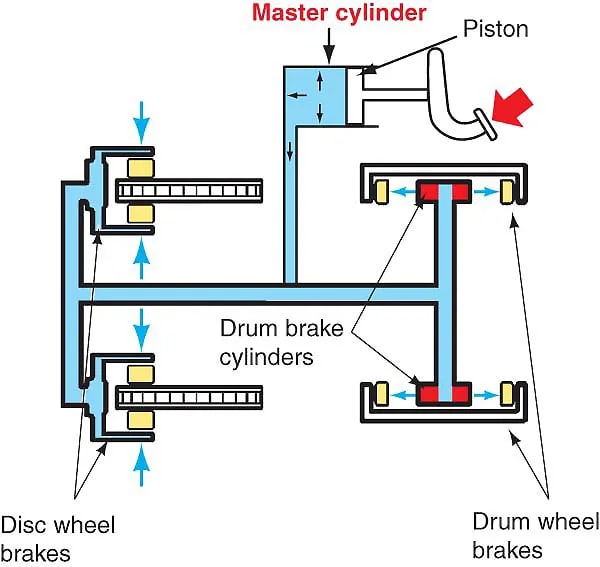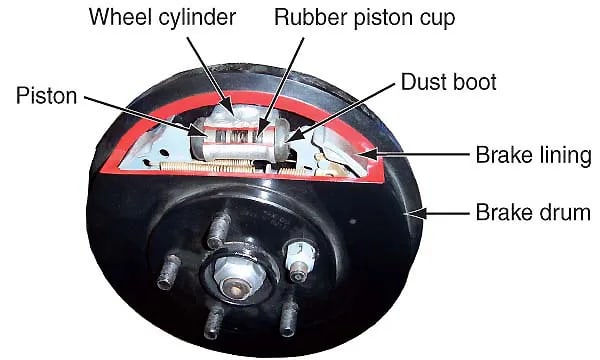What Is Brake Fluid?
What is brake fluid? Learn more about the basics of brake fluid and how to monitor it and more with automotive training at UTI!
Key Points
- The braking system is the most important safety system in a vehicle and helps bring the vehicle to a complete stop.
- There are two primary types of braking systems in passenger vehicles: disc brakes and drum brakes.
- Drum brakes were the first type of braking system introduced and use hydraulic pressure to slow down the wheels.
- Disc brakes are the standard for most vehicles and use brake calipers and steel rotor discs to create friction and slow down the wheels.
- Signs of worn brake parts include vibrations in the steering wheel, having to press the brake pedal down hard, loud noises, the car pulling to one side and the brake light on the dashboard coming on.
There’s no safety system on a vehicle more important than the braking system. This system helps slow down the rotation of the wheels when the brake pedal is depressed, ensuring a vehicle comes to a complete stop.
There’s a lot going on within a braking system during this process. Keep reading to learn more about the different types of car brakes, the parts they include and how they work.
Braking systems in passenger vehicles use two primary types of brakes: disc brakes and drum brakes. While they both bring a vehicle to a stop, they differ in design and operation.

Disc brakes are the only type used in the front of vehicles but may be found on all four wheels. All passenger vehicles made and sold in the United States will have disc brakes on the front and possibly the rear as well, while drum brakes will only be found on the rear of U.S autos.
Drum brake systems were the first in-tire systems introduced, released in 1900 and patented in 1902 by engineer Louis Renault. While the first designs were completely mechanical and used levers to operate, by the mid-1930s they were applied using hydraulic pressure.
How do drum brakes work? This system consists of a master cylinder that sends pressurized brake fluid to the wheel cylinder located inside the brake drum. This pressure causes the pistons in the cylinder to expand and press the brake shoes against the inner surface of the brake drum, which creates friction to help slow the spinning of the wheels.
While disc brakes were patented the same year as drum brakes, it took almost half a century for the designs to become practical and cost-effective for use in automobiles.
Their superior performance over drum brakes was first realized by Jaguar in 1953, when they used them on a race car that triumphed over other cars using drum brakes. Later that same year, a production car was sold with all disc brakes. Since then, they’ve been considered the standard for most vehicles.
This system consists of a master cylinder that sends pressurized brake fluid to the brake caliper, causing its pistons to press against a steel rotor disc, creating friction to slow the spinning of the wheels.
While drum brakes have their place, they also have disadvantages when compared with the disc type. Manufacturers have come to prefer the disc braking system because of its many advantages, which include:
Every part of the brakes of a car plays a key role in the stopping process. While disc and drum brakes have some similar parts, they do differ quite a bit.
The drum brake system consists of the master cylinder, wheel cylinders, primary and secondary brake shoes, multiple springs, retainers and adjustment mechanisms.

When it comes to how long these parts last, a lot of variables come into play. Typically, the drum brake housing (the drum itself) is designed to last between 150,000 and 200,000 miles. Brake shoes have a lower lifespan depending on use, usually anywhere between 35,000 to 60,000 miles.
Major parts of a disc brake system include the master cylinder, caliper, rotor and pads.
How long do disc brake pads last? The answer to this varies based on a range of factors, including how much pressure is applied during the stopping process and how often they’re used. Automotive technicians usually estimate most vehicles will get between 25,000 to 65,000 miles for brake pads and 30,000 to 70,000 miles for brake rotors.

The best thing to do is just pay attention to how your car feels during the braking process and get the system checked out on a regular basis to catch problems early.
There are several indicators of problems with different parts of the braking system. It’s important to get your car checked when you notice these things to ensure you get any necessary repairs done:
Car brakes work by converting kinetic energy into heat energy through friction, allowing the vehicle to slow down or stop. This process is facilitated by a hydraulic system that amplifies the force applied by the driver.
Brake fluid plays a crucial role in a car's braking system, ensuring the proper functioning of the brakes by transmitting force from the brake pedal to the brake components at the wheels. It helps with lubrication for the moving parts within the system and has a high amount of heat resistance.
Some signs of worn-out brake pads may include squeaking, squealing or grinding noises. You may also notice reduced brake performance or vibrations as you drive.
Pursuing a career as an automotive technician can help give you the opportunity to learn all about car brake systems. The skilled trades are growing — total auto technician employment is expected to exceed 815,000 by 2033.47Training as an automotive technician at Universal Technical Institute (UTI) can give you the knowledge and skills employers are looking for when hiring.1
Courses taught over UTI’s 51-week Automotive Technology program cover a range of topics for the role, including a section about vehicle braking systems. You can graduate in less than a year ready for an entry-level position in the industry!7
Interested in finding out more? Request more information, or call 800-834-7308 today!
Universal Technical Institute of Illinois, Inc. is approved by the Division of Private Business and Vocational Schools of the Illinois Board of Higher Education.